Do you want to hear a bitter truth about ecommerce success?
You cannot achieve it in a full-fledged organic method.
There you go! Now that the cat is out of the bag, let’s admit the fact that paid advertising has become a mandatory growth arsenal for ecommerce brands that are looking to scale and aiming to double or triple sales.
The only you can achieve those goals through performance marketing is by making the right choice in terms of choosing platforms and adopting strategies. But with so many platforms, algorithms, formats, and costs to consider, choosing the right ad platforms can feel like gambling with your budget.
This blog is your shortcut. Whether you’re scaling a DTC (Direct-to-consumer) brand, running high-ticket dropshipping, or launching a niche product on Shopify, we’ll break down exactly where to run ecommerce ads in 2025 and why. You’ll learn:
- The basics of ecommerce advertising.
- Top ecommerce ad platforms suggested by Kaya’s team.
- Factors to consider when choosing a platform.
- Ecommerce ad trends to look out for.
Instead of giving you surface-level tips or generic “try Facebook” advice, we’ll walk through the best platforms one by one and complete with targeting capabilities, ideal formats, campaign examples, and budget guidance.
Let’s get started.
What are ecommerce ads and how do they work
Ecommerce ads include any paid promotion that pushes a product online, typically linking directly to a product detail page (PDP), collection, or landing page. Common examples:
- A carousel of product images on Instagram with “Shop Now” buttons
- A Google Shopping ad showing your product image, price, and ratings when someone searches “ceramic mugs”
- A TikTok video from a creator demo-ing your product boosted with paid spend
- A retargeting display ad showing the exact item someone left in their cart yesterday
These ads work like tailored moments built to catch buyers in the right mindset, at the right time.
How targeting works for ecommerce ads
Ecommerce ads are effective because of their precision. Platforms like Meta, Google, and TikTok give you access to layered targeting options:
- Interest-based (e.g. people who like skincare)
- Behavioral (e.g. people who recently engaged with similar products)
- Contextual (e.g. searchers typing in “waterproof sneakers”)
- Lookalikes (people similar to your past buyers)
- Retargeting (people who viewed, added to cart, or abandoned checkout)
Because of these options, you’re not just guessing who might want your product. Rather you’re working with data to reach high-intent audiences. In 2025, this targeting is increasingly automated through machine learning, but still rely on clean signals (like pixel events, product feeds, and CRM data).
Importance of visuals and messaging in ecommerce advertising
Besides platforms, visuals and messaging can set the fate of your ecommerce advertising performance. Here you’re not selling features; you’re selling how your product fits into someone’s life. That’s why your creative i.e., visuals, copy, and overall vibe is everything.
Visuals need to feel native to the platform. A UGC-style (User Generated Content) unboxing video performs better on TikTok than a polished brand shoot. A minimalist product shot with a price overlay might crush it on Google Shopping but flop on Pinterest. The key is contextual relevance.
Messaging should address outcomes. Here’s an example of an umbrella’s ad copy: “keeps you dry on rainy commutes” > “waterproof material.” You want your copy to do one of three things: stop the scroll, show the benefit, or push urgency. And ideally, all three.
How ecommerce brands use customer data to improve ads
Every click, view, and scroll is a data point. The best ecommerce brands use this feedback loop to:
- Retarget with dynamic product ads (showing users the exact product they browsed)
- Build lookalike audiences from high-LTV (Life Time Value) customers
- Feed pixel data into smart campaigns (e.g., Meta’s Advantage+ or Google’s PMax aka Performance Max)
- Trigger email or SMS follow-ups for abandoned carts or views
Even without third-party cookies, platforms now rely more on first-party signals. This means the cleaner your own data (from platforms like Shopify, Klaviyo, GA4 or Google Analytics), the better your ads perform.
Best platforms to run ecommerce ads in 2025
There’s no “one right” ecommerce ad platform. Some platforms are built for high-intent search. Others are for scroll-stopping visuals. Some are perfect for retargeting abandoned carts, while others help you launch something new with a bang.
If you’re running a multi-channel setup, you’ll want to mix platforms across different stages of the funnel — from awareness to conversion. But if you’re just starting, even one or two of these can be enough to scale profitably.
Let’s start with the biggest player in the game.
1. Meta (Facebook and Instagram Ads)
Meta remains the most versatile and scalable ad platform for ecommerce brands in 2025. With billions of monthly users across Facebook and Instagram, advanced behavioral targeting, and a product suite designed specifically for online shopping, Meta is still the top choice for DTC and multi-product brands. Its algorithm is trained to optimize for purchase and its native shopping features make product discovery frictionless.
Why it’s best for ecommerce ads
Meta’s blend of broad reach, dynamic creative delivery, and in-app shopping makes it a perfect match for ecommerce. You can target cold prospects with broad-interest Advantage+ campaigns, retarget high-intent visitors with dynamic product ads, and close sales directly inside Instagram. The platform’s strength lies in how well it understands user behavior and adapts to performance in real time, especially if you feed it the right creative signals and product data.
Best ad formats for ecommerce
- Dynamic product ads (DPAs): Automatically show users products they viewed, added to the cart, or might like; crucial for retargeting
- Collection ads: Combine video + product catalog for a seamless scroll-to-shop experience
- Carousel ads: Showcase multiple products or benefits in one frame
- Reel ads: High-engagement vertical videos, ideal for UGC-style storytelling
- Advantage+ Shopping Campaigns (ASC): Fully automated campaign type optimized for conversions using your product catalog
Best practices for ecommerce ads on Meta
- Use Advantage+ Shopping Campaigns to find high-converting audiences fast when you have a large catalog or limited creative bandwidth
- Feed the algorithm 3–5 strong creatives per ad set, mixing static images, UGC, and product demos
- Retarget with DPAs using catalog-based triggers like product views and add-to-carts
- Make your creatives feel native: Reels should look like influencer content, not TV spots
- Layer in urgency and offer logic in your copy such as “limited stock” and “free shipping
- Start with enough budget — at least $1,000/month so the algorithm has enough signal to optimize purchases at scale
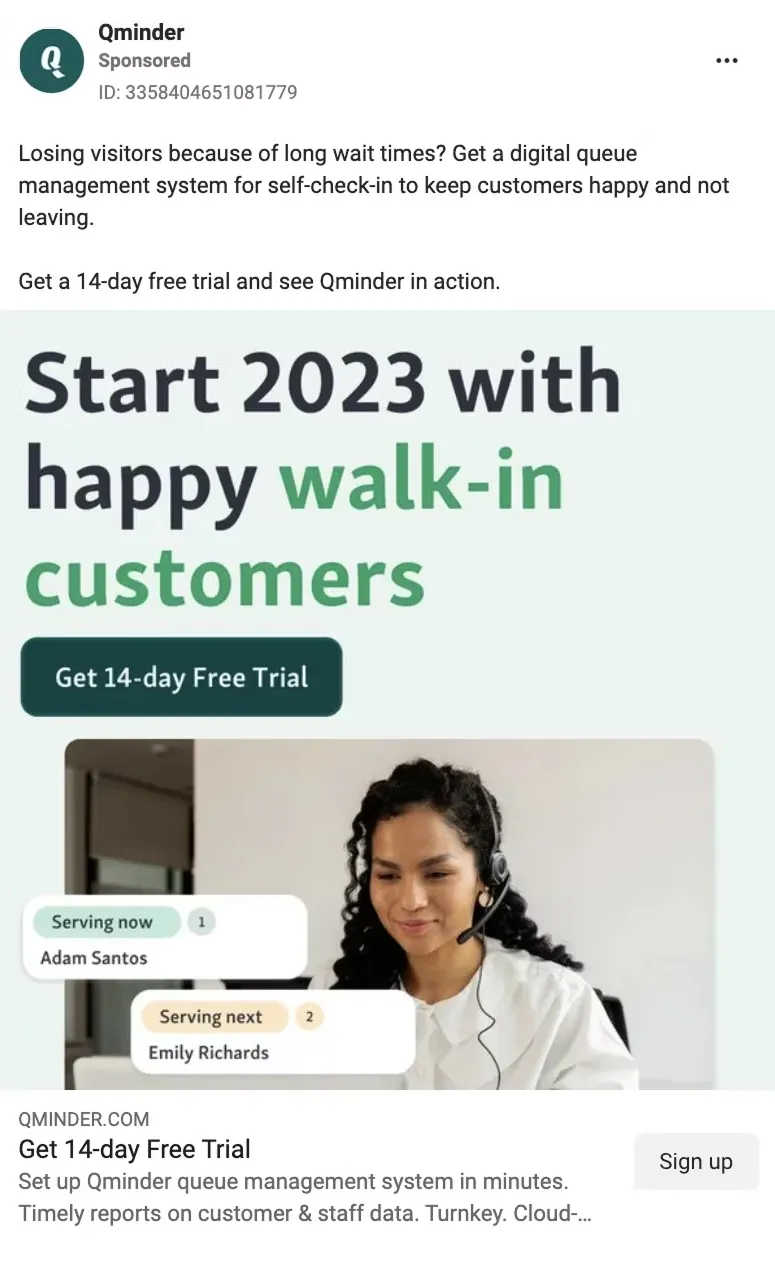
Example of a Meta Ad
2. Google Ads
Google Ads is the go-to platform for capturing high-intent buyers at the moment they’re actively searching. From branded search terms to detailed product queries, Google places your products directly in front of people with purchase intent. With its ecosystem spanning Search, Shopping, YouTube, Gmail, and Display, it gives ecommerce brands unmatched reach across the entire customer journey.
Why it’s best for ecommerce ads
What makes Google Ads so effective for ecommerce is the ability to align with real-time demand. If someone’s searching for “best leather backpack under $200,” they’re likely deep in the buying mindset. And Shopping Ads put your product, price, and reviews front and center. With the rise of Performance Max (PMax), Google now also uses AI to automate targeting, creative placement, and bidding across all surfaces, which is a huge win for brands with growing catalogs and limited internal media teams.
Best ad formats for ecommerce
- Shopping Ads: Show product image, price, store name, and rating right in search results, ideal for physical product brands
- Search Ads: Keyword-triggered text ads, best used for branded terms, product categories, and competitor conquesting
- Display Ads: Static or animated banners ideal for retargeting or low-cost awareness
- YouTube Ads: In-feed and pre-roll video placements to boost upper-funnel interest
- Performance Max Campaigns: Google’s AI-powered format that combines all the above into one optimized campaign across surfaces
Best practices for ecommerce ads on Google
- Set up Performance Max with clear conversion goals (purchases or ROAS/Return on Ad Spend) and feed it a strong product catalog through Google Merchant Center
- Use branded search campaigns to protect your name and win high-converting clicks
- Layer in competitor targeting by bidding on category and brand competitor keywords
- Retarget via Display using custom audiences (cart abandoners, product viewers)
- Monitor product feed quality. Clear titles, clean imagery, and accurate pricing dramatically improve Shopping ad performance
- Start with $1,500/month minimum for PMax or a mix of Shopping + Search; scale as soon as you see stable conversion data

Example of a Google Ad
3. TikTok Ads
TikTok has become a powerhouse for ecommerce discovery, especially among Gen Z and younger millennials. Unlike traditional platforms, TikTok thrives on native, scroll-stopping video content that blends entertainment and product promotion. In 2025, TikTok has transformed into a performance channel where product videos go viral, communities shape trends, and direct sales happen through TikTok Shop integrations.
Why it’s best for ecommerce ads
TikTok is where visual storytelling meets product-led content. If your product has strong “before/after,” demo potential, or emotional appeal, TikTok gives you unmatched creative reach. What’s more, its algorithm is interest-first, not follower-based, which means even new brands can gain serious traction with the right ad. With the rollout of TikTok Shop across more regions, the platform is becoming a closed-loop ecommerce engine: discover, engage, and buy, all in one app.
Best ad formats for ecommerce
- In-Feed Video Ads: Appear natively within the user’s "For You" feed. This is ideal for UGC and creator-style content
- Spark Ads: Boost organic creator videos directly from their profiles. This combines social proof + performance
- Collection Ads: In-feed video paired with a product gallery below; users can browse without leaving the video experience
- Dynamic Showcase Ads (DSAs): Automatically promote products from your catalog based on user behavior and preferences
- Top View & Branded Effects (for larger campaigns): High-impact formats to build virality and reach
Best practices for ecommerce ads on TikTok
- Hook in the first 3 seconds. Humor, curiosity, or “I wish I knew this sooner” angles work best
- Use UGC or creator partnerships. Founder-led content, unboxings, and voiceovers feel more trustworthy than polished ads
- Keep videos under 30 seconds with strong visual demos or lifestyle use cases
- Leverage TikTok Shop integration if available in your region; lower friction leads to higher conversion
- Test 4-6 video angles per product, and iterate based on watch time, click-through rate, and add-to-cart
- Start with $30–50/day (~$1,000–$1,500/month) for enough delivery data. Scale if a video starts compounding in reach
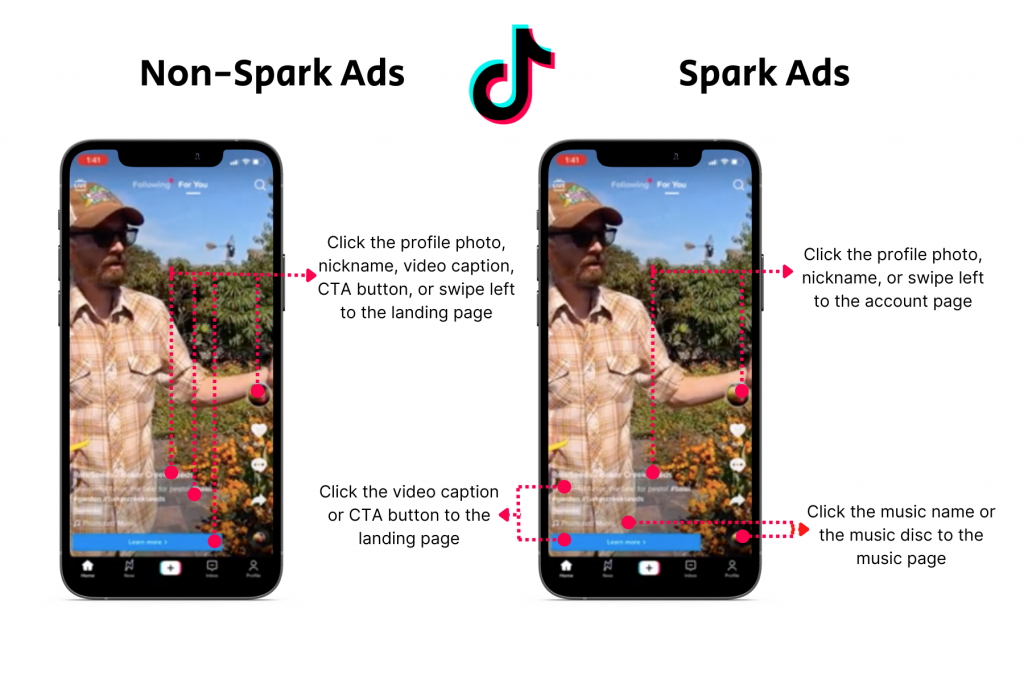
Examples of TikTok Ads
4. Pinterest Ads
Pinterest works like a visual discovery engine which makes it uniquely powerful for ecommerce brands selling lifestyle products, home decor, fashion, beauty, or anything highly visual. People come to Pinterest to plan future purchases, get inspiration, and build vision boards. This implies that you’re reaching users earlier in the funnel but with very real buying intent.
Why it’s best for ecommerce ads
Unlike TikTok or Instagram, Pinterest users are actively searching and saving ideas around a specific goal — from “outfits for Italy trip” to “boho bedroom lighting.” That means your ads have an opportunity to blend directly into their intention-driven behavior. You can tap into evergreen demand (like holiday shopping, back to school, or weddings) or seasonal spikes with well-placed product pins. And because Pinterest skews heavily female and high-income, it’s especially effective for brands targeting that demographic.
Best ad formats for ecommerce
- Standard Pins: Promoted versions of static images that appear in search results and feeds
- Video Pins: Short videos to show product usage or styling; high engagement, especially for beauty, wellness, and fashion
- Shopping Ads: Pull directly from your product catalog and appear when users search for relevant products
- Collections Ads: One hero creative paired with several product images below; ideal for promoting product sets or bundles
- Idea Ads (formerly Story Pins): Multi-page formats used by creators; best used for organic, community-driven content
Best practices for ecommerce ads on Pinterest
- Target keyword-driven search queries. Think like your customer: “cozy minimalist living room” or “summer capsule wardrobe”
- Design thumb-stopping vertical creatives. Product in use, clean aesthetic, and clear text overlays work well
- Use lifestyle imagery over product-only shots
- Leverage Pinterest Trends to align your ads with what’s seasonally relevant
- Optimize your product feed to ensure titles, descriptions, and pricing match search intent
- Start with $25–$40/day and layer in both prospecting and retargeting campaigns
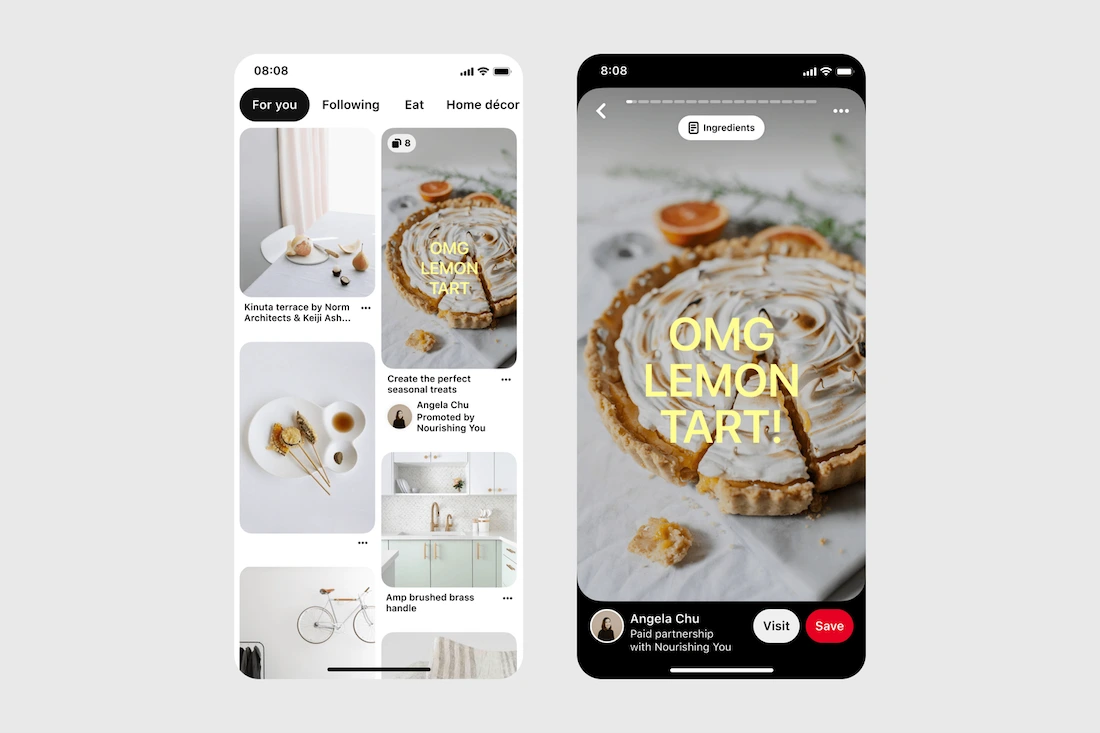
Examples of Pinterest Ad
5. Amazon Ads
If you sell on Amazon, running ads within its ecosystem is essential. Amazon Ads helps you stand out in a sea of similar products by pushing your listings to the top of search results and key placements. But even if you’re a DTC brand, Amazon’s growing display and DSP (Demand Side Platform) capabilities give you access to high-intent shoppers both on and off Amazon.
Why it’s best for ecommerce ads
Amazon is the world's largest product search engine. Most buyers go there when they’re ready to buy. With ad formats tied directly to purchase behavior, you can capture demand at the decision-making stage. Plus, its retail media tools give you access to targeting based on actual shopping data (what people view, buy, or abandon). That level of commercial intent is hard to beat. If you sell on Amazon, ads can boost ranking, increase reviews, and drive the flywheel. If you don’t, Amazon DSP still lets you reach shoppers across the web-based on Amazon behavioral signals.
Best ad formats for ecommerce
- Sponsored Products: Appear in search results and on product pages, high-converting and scalable
- Sponsored Brands: Banner-style ads with logo, custom headline, and multiple product listings, great for brand awareness
- Sponsored Display: Retarget users both on and off Amazon; helps capture warm traffic
- Amazon DSP: Programmatic display ads based on Amazon’s shopper data, even if you don’t sell on Amazon
- Video Ads (Sponsored Brands Video): Autoplay product demos in search results; strong scroll-stoppers
Best practices for ecommerce ads on Amazon
- Start with Sponsored Products to drive traffic to high-converting SKUs (Stock Keeping Unit). Focus on those with strong ratings and reviews
- Use auto + manual targeting to capture broad queries and refine exact keywords over time
- Segment campaigns by product category or price tier to control bids and budgets more effectively
- Leverage Sponsored Brands to increase discoverability and push bundles or collections
- Use Sponsored Display to re-engage viewers who didn’t convert or cross-sell related products
- Start with $30–50/day per campaign, especially if launching multiple SKUs, then scale based on ACOS and TACOS benchmarks
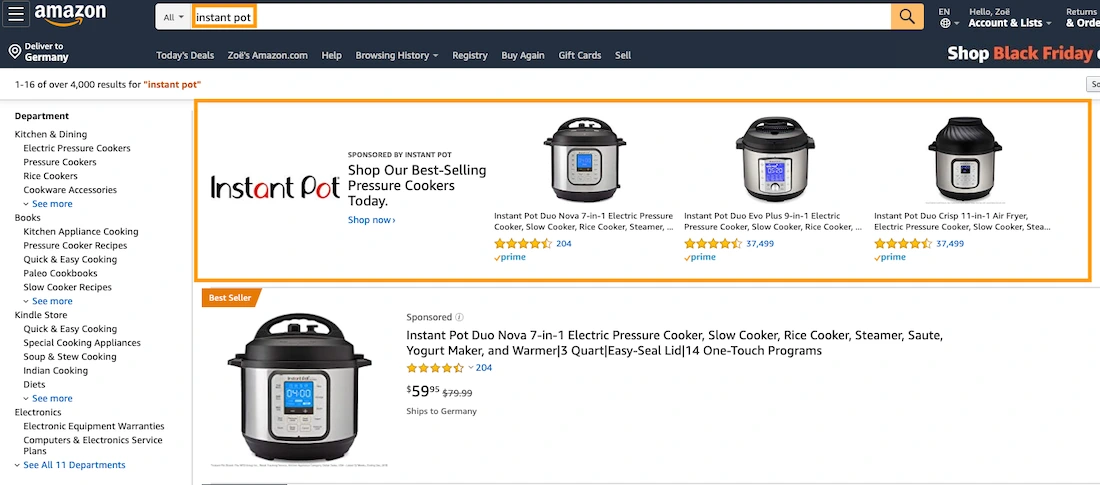
Example of an Amazon Ad
6. YouTube Ads
With deep integrations into Google’s ad ecosystem, YouTube lets you tap into intent-rich audiences, retargeting pools, and in-market segments — all while using highly engaging, product-led video content.
Why it’s best for ecommerce ads
YouTube sits at the intersection of intent and immersion. Unlike social platforms, users come to YouTube to learn, solve problems, or explore. This gives you a longer window to educate and convert. From unboxings and product demos to comparison videos and influencer collaborations, ecommerce brands can build trust while driving action. And thanks to Performance Max and YouTube Shopping Ads, you can now link product feeds directly into video placements.
Best ad formats for ecommerce
- In-Stream Skippable Ads: Run before or during videos; you only pay when users watch 30 seconds or click
- In-Feed Video Ads: Appear in YouTube search results and alongside related videos
- YouTube Shopping Ads: Overlay your video with a scrollable product feed pulled from your Merchant Center
- Bumper Ads (6-second non-skippable): Best for mass reach or retargeting
- Performance Max video placements: Automatically distribute your videos to the right audience across YouTube + Google surfaces
Best practices for ecommerce ads on YouTube
- Open with a hook in the first 5 seconds. Ask a question, show the transformation, or use bold motion to grab attention
- Use voiceover and text overlays; any users watch muted, especially on mobile
- Show the product in action. Demos, use cases, comparisons, and social proof increase engagement and trust
- Combine YouTube with your PMax campaigns to drive both upper-funnel interest and mid-funnel conversion
- Use remarketing audiences from your Google Ads account (site visitors, cart abandoners) for high-efficiency retargeting
- Start with $40–$60/day per campaign. Prioritize a strong creative and test multiple video lengths (15s, 30s, 60s)
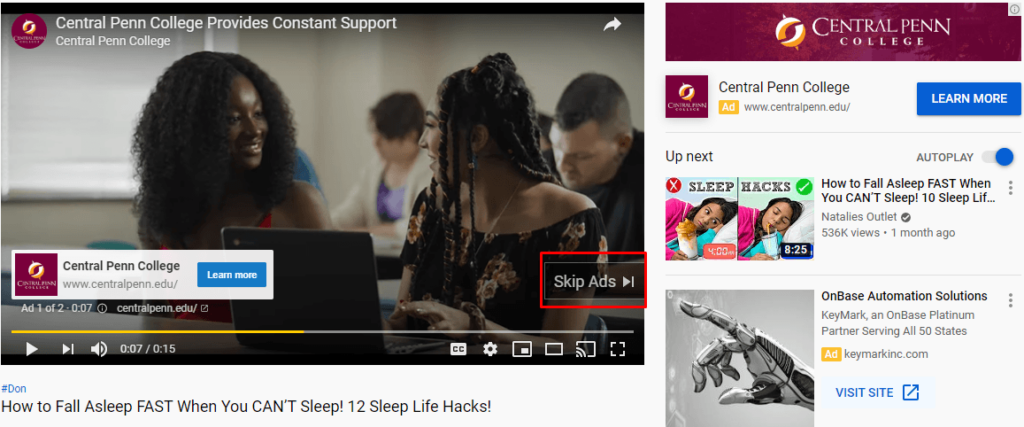
Example of a YouTube Ad
7. Microsoft Advertising (Bing Ads)
Often underestimated, Microsoft Advertising (formerly Bing Ads) is a hidden gem for ecommerce brands targeting older, high-income, and desktop-heavy audiences. It powers search ads not just on Bing, but also on Yahoo, AOL, DuckDuckGo, and Microsoft’s ecosystem. That reach, combined with lower CPCs (Cost Per Click) and less ad competition, makes it a cost-efficient complement to Google Ads.
Why it’s best for ecommerce ads
Microsoft Ads excel when your customer base skews older, more affluent, or business-oriented — think premium products, gifting categories, or B2B ecommerce. The platform also integrates with Microsoft Shopping Campaigns, allowing you to showcase products directly in search results like Google Shopping. And because most brands ignore Bing, competition is lighter, allowing for cheaper clicks and often better ROAS, especially on branded and long-tail terms.
Best ad formats for ecommerce
- Search Ads: Keyword-triggered text ads across the Bing search network, great for brand, product, and category terms
- Shopping Ads: Product listings that show image, price, and merchant name; ideal for high-intent searches
- Microsoft Audience Ads: Native display ads shown across Microsoft-owned properties and partner sites
- Dynamic Search Ads: Auto-generate text ads based on your website, helpful for large product catalogs
- Multimedia Ads: Visual-rich search ads combining image + text (newer format with higher Click-through-rate potential)
Best practices for ecommerce ads on Microsoft
- Import your top-performing Google campaigns into Microsoft Ads to quickly mirror success
- Use Shopping Campaigns if you have a physical product catalog. Ensure your feed is optimized via Microsoft Merchant Center
- Run branded and competitor search campaigns; lower CPCs let you own high-value terms affordably
- Set up Audience Ads for retargeting and low-cost brand reinforcement across Microsoft’s ecosystem
- Test Multimedia Ads to grab more visual attention in the SERP, particularly for lifestyle or giftable products
- Start with $20–$30/day, especially if you're duplicating Google success
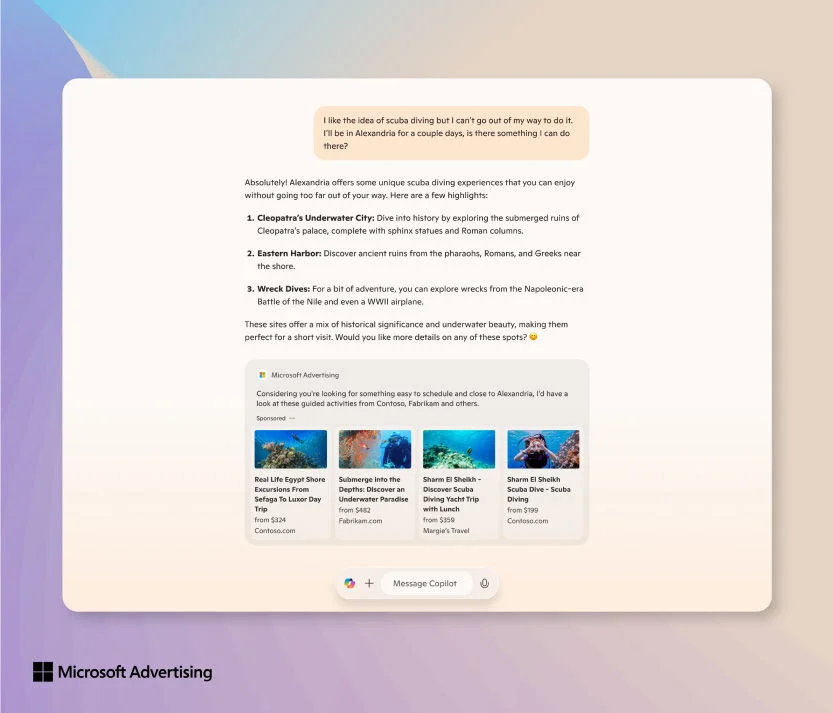
Example of a Copilot (Microsoft) Ad
8. Snapchat Ads
Snapchat may not be the flashiest platform in 2025, but it remains a high-performing channel for ecommerce brands targeting Gen Z and younger millennials. With visual-first formats, quick consumption behavior, and strong engagement in vertical video, Snapchat helps product-focused brands reach users during their most casual, impulsive scrolling sessions, specifically in fashion, beauty, accessories, and novelty product categories.
Why it’s best for ecommerce ads
Snapchat’s strength lies in its low CPMs (Cost per Mille), immersive ad formats, and its ability to drive quick impulse purchases with native-feeling creative. Users are highly engaged in short bursts, which makes it perfect for fast-paced product demos, flash offers, and social-proof-driven UGC.
Best ad formats for ecommerce
- Single Image or Video Ads: Full-screen vertical formats that show between Stories or Discover content
- Collection Ads: Show a hero image/video with tappable product tiles below, great for browsing multiple SKUs
- Story Ads: Branded story experiences that users can swipe into from the Discover tab
- Dynamic Product Ads (DPAs): Automatically retarget users with products they viewed or added to cart
- Lenses & AR Ads (optional): Try-before-you-buy filters for beauty, fashion, or accessories, best for viral reach
Best practices for ecommerce ads on Snapchat
- Keep creatives under 10 seconds and punchy. Open strong, show the product fast, and end with a clear CTA
- Use UGC-style or lo-fi content to match Snapchat’s casual vibe
- Enable Dynamic Product Ads to retarget product viewers with catalog-driven placements
- Run Collection Ads during product launches or sale periods to increase browsing time and basket size
- Use swipe-up CTAs with urgency-driven messaging (“shop now,” “limited drop,” “ends today”)
- Start with $20–$40/day, and scale based on swipe-through rate, add-to-cart volume, and ROAS
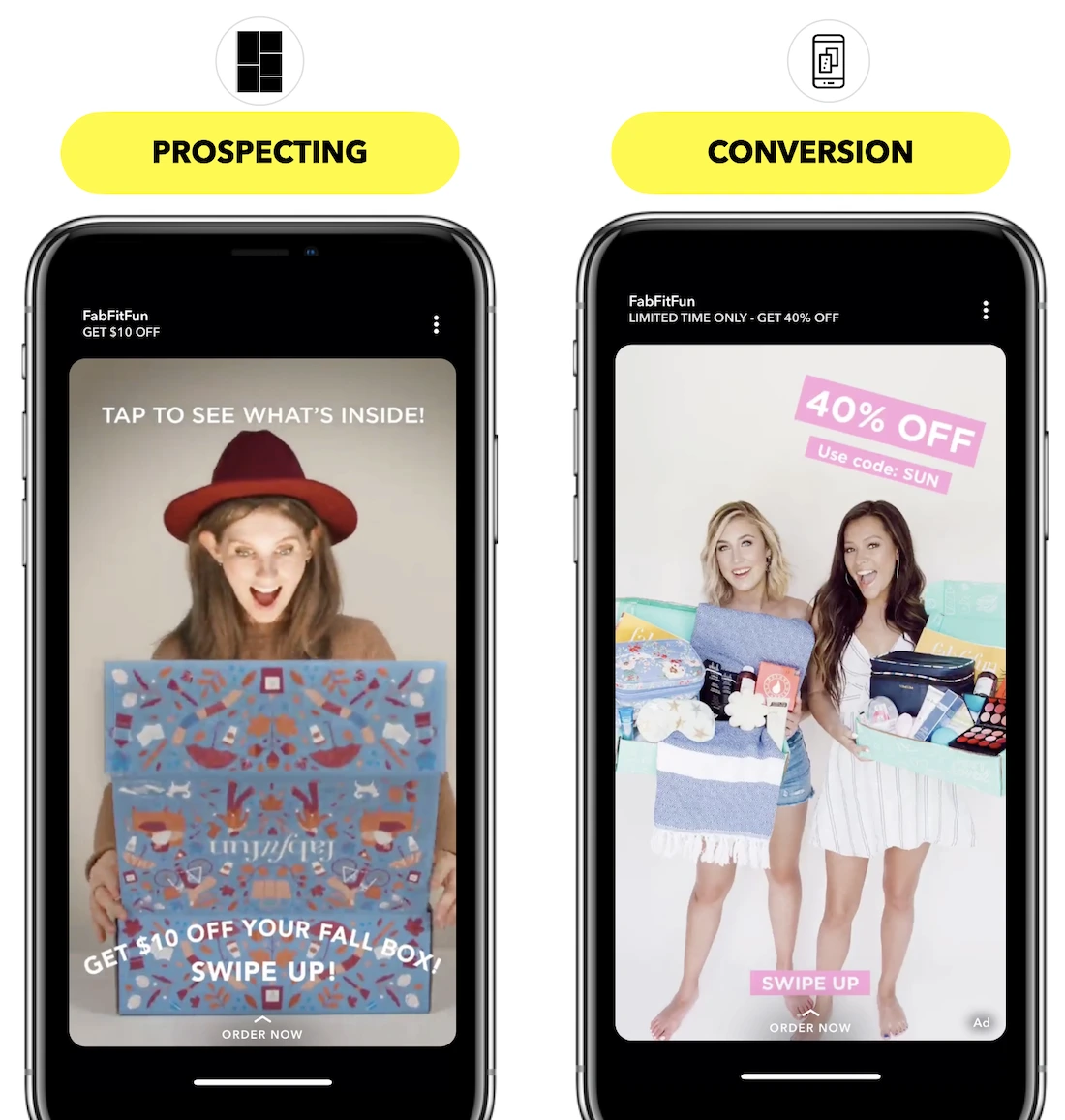
Examples of Snapchat Ad
9. Reddit Ads
Reddit isn’t the first place most ecommerce brands consider. And that’s exactly why it works. Reddit Ads allow you to reach highly engaged niche communities (called subreddits) where users share honest opinions, product recommendations, and reviews. If your product solves a specific problem, caters to a hobbyist audience, or sparks discussion, Reddit gives you direct access to people who actually care.
Why it’s best for ecommerce ads
What sets Reddit apart is intent + trust. Users turn to it for advice before buying: “What’s the best standing desk under $300?” or “Is Brand X actually worth it?” Ads that don’t feel like ads and genuinely add value to the conversation can drive huge traffic and conversions. While the scale is smaller than Meta or Google, the conversion quality is often higher for brands that hit the right communities.
Best ad formats for ecommerce
- Promoted Posts: Appear in-feed like organic Reddit posts, best for driving discussion and site traffic
- Promoted Video: Looping or autoplay video within posts, good for product demos and storytelling
- Display Banners: Static ads that show on subreddit sidebars or feeds, more top-of-funnel
- Conversation Ads: Encourage direct user replies, great for AMAs, feedback loops, or product launches
- Audience Targeting Ads: Segment by interest (e.g. skincare, fitness) or subreddit (e.g. r/CampingGear, r/MaleFashionAdvice)
Best practices for ecommerce ads on Reddit
- Write like a Redditor, not a brand. The conversational tone and honesty outperform polished ad-speak
- Target specific subreddits where your product is genuinely relevant, not just broad interests
- Launch a promoted post that mirrors organic questions ("Is X worth it?" or "What finally helped your dry skin?")
- Use social proof such as customer reviews, personal stories, or creator testimonials
- Engage in the comments to build authenticity and surface answers; Reddit rewards real interaction
- Start with $20–$30/day and test across 2–3 subreddits before scaling
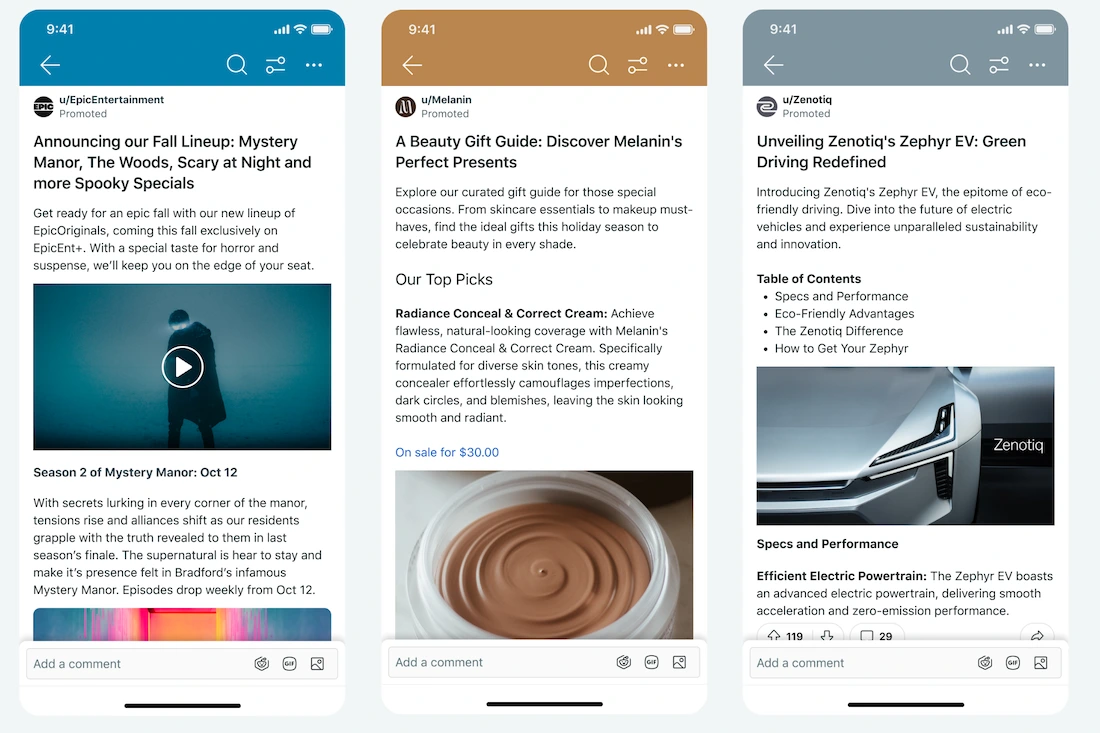
Examples of Reddit Ad
10. XHS (XiaoHongShu) Ads
XHS, also known as XiaoHongShu or “RedNote”, is a rising ecommerce powerhouse in China and Southeast Asia, where product discovery blends lifestyle inspiration with social proof. It's especially effective for brands in skincare, wellness, fashion, and lifestyle categories targeting Gen Z and Millennial shoppers. While organic content is the foundation, paid advertising on XHS helps brands accelerate growth by boosting visibility and reaching niche consumer communities faster.
Why it’s best for ecommerce ads
XHS combines the trust of UGC with the reach of a high-intent discovery platform. Users of this platform search, save, and share Notes when planning purchases. Paid ads on XHS let you amplify your best-performing organic content, drive campaign-specific visibility, and collaborate with trusted KOLs (Key Opinion Leader)and KOCs (Key Opinion Customer) to reach the right audiences. For brands expanding into China or APAC, it offers precise targeting and premium placements through its enterprise ad platform, Juguang.
Best ad formats for ecommerce
- In-feed ads: Native-style creatives that blend into the user feed, best for driving engagement and click-throughs
- Splash ads: Full-screen ads that appear when the app opens, ideal for product launches and mass awareness
- KOL and KOC collaborations: Partner with influencers or real consumers to generate authentic, trust-building ad content
- Search-based promotions: Target product-specific queries with sponsored Notes or strategically placed brand content
Best practices for ecommerce ads on XHS
- Mimic organic Notes in your ads. Story-driven content with lifestyle visuals performs better than sales-heavy formats
- Use Juguang’s targeting capabilities to reach the right audience by interest, demographics, and user behavior
- Start with smaller budgets to test creatives and formats, then double down based on data
- Combine paid and organic content in your calendar for maximum impact. While paid amplifies, organic builds trust
- Track performance through XHS’s native analytics tools to refine messaging, visuals, and placement strategy
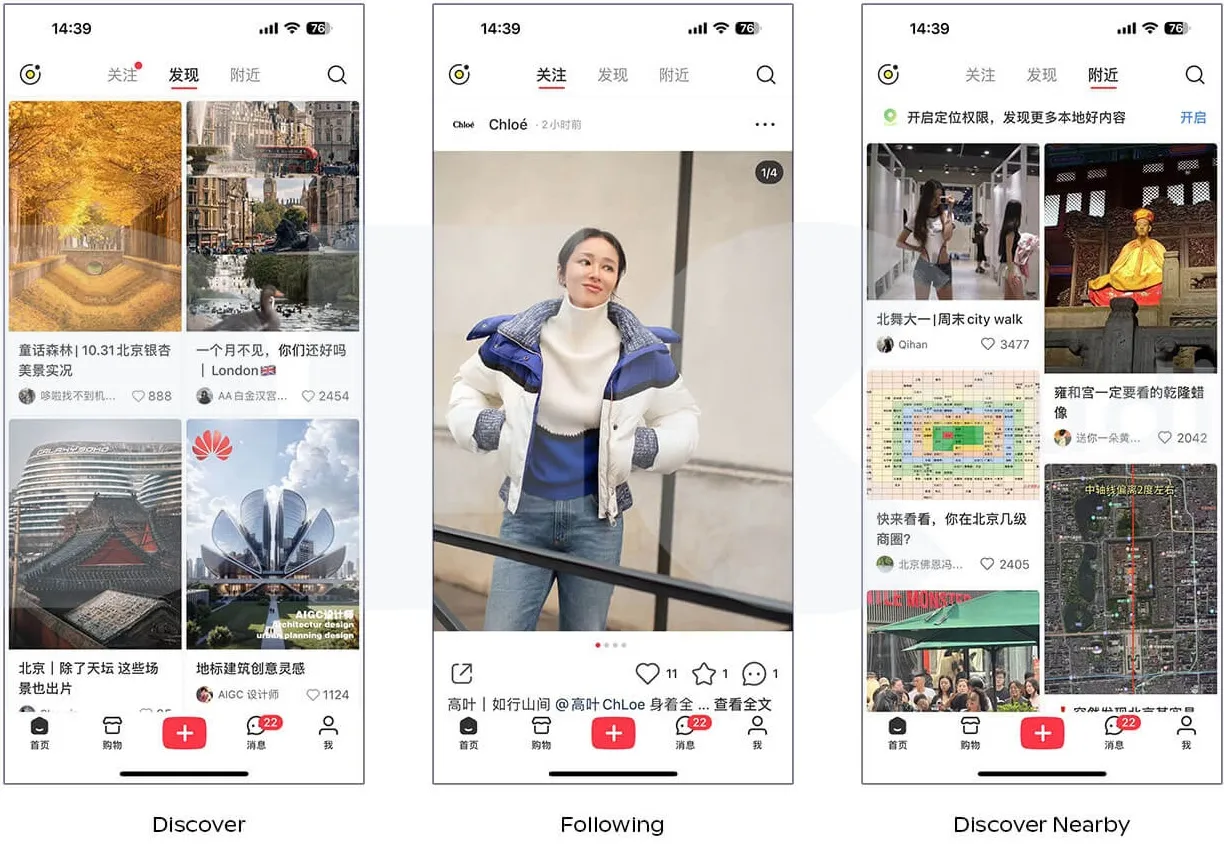
Examples of XHS Ad
Criteria for choosing the right ecommerce ad platforms
Choosing the right ad platform isn’t about picking the most popular, it’s about picking the one that fits your product, audience, and growth stage. Here’s a framework you can use to make smarter, more profitable decisions when selecting where to run your ecommerce ads in 2025:
Audience demographics and platform usage
Where does your target buyer actually spend time? While TikTok and Snapchat skew Gen Z, Pinterest attracts millennial women planning purchases. And Meta reaches broader demographics. Hence, choose your ad platform based on behavioral fit, not hype.
Purchase intent and buyer journey stage
Google and Amazon win when buyers are searching with intent. On the other hand, TikTok, Pinterest, and Meta are better at creating desire at the top and mid-funnel. A good strategy would be to layer platforms across the funnel to guide users from discovery to checkout — thus pushing you to adopt a cross-channel paid strategy.
Ad format compatibility
If your product shines in motion or demo, lean into platforms with video strength (TikTok, YouTube, Meta Reels). If it’s visual and aspirational, Pinterest and Instagram thrive. If it solves a niche problem, Reddit and Rednote give you storytelling room. Match your creative strength to the platform’s native formats.
Cost per click (CPC) or cost per acquisition (CPA)
Don’t just chase low CPCs. Track what actually converts. Sometimes $2 CPC on Meta leads to a $40 purchase while $0.30 clicks on Display bring low intent. Thus, you should monitor your blended CAC (Customer Acquisition Cost) and know which platforms are driving profitable sales.
Ad targeting capabilities
Meta and Google still lead in audience precision, especially when fueled by your pixel and first-party data. TikTok is also catching up with interest-based targeting. On the other hand, Amazon offers great shopping intent targeting while Reddit lets you go deep with subreddit-based precision. Choose your ad platform based on your business priorities.
Creative flexibility and visual appeal
TikTok, Meta, and YouTube let you be playful, visual, and bold. Pinterest rewards aesthetic curation. Google and Amazon are more functional and utilitarian. On the other hand, Amazon’s native platform now offers AI-generated creative functionality. At the end of the day, you should choose the platform that lets your product storytelling thrive with minimal effort.
Attribution tracking and data insights
Google and Meta offer the strongest attribution ecosystems, especially with offline conversions or multi-channel paths. Platforms like Reddit or Snapchat may require more manual UTM setup and blended attribution modeling. Depending on what you can afford, pick your choice.
Emerging trends shaping ecommerce ads in 2025
In 2025, ecommerce brands winning with paid ads aren’t just iterating on what’s working, they’re building systems for what’s next.
On one hand, AI-generated creatives are speeding up testing cycles, allowing brands to scale variations faster while keeping strategy human-led. Video is dominating the funnel, from TikTok discovery to shoppable walkthroughs, and brands are treating video creation as core infrastructure.
On the other hand, first-party and zero-party data are becoming vital as third-party tracking fades. This means quizzes, surveys, and CRM signals now power your best-performing lookalikes and exclusions.
Moreover, paid and organic strategies are merging into unified UGC ecosystems, where Spark Ads and repurposed content drive performance. Creator-led ads are outperforming polished brand visuals, pushing budgets toward micro-influencer collaborations and testimonial-style content.
The only way to tackle all these trends while making sure your ads keep on platforming is to stay informed and have contingency plans no matter how the situation might turn out.
Tips for running high-performing ecommerce ad campaigns
-
Align creatives with funnel stages
Don't just push products. Tailor your creatives to where the user is in their journey. Use scroll-stopping visuals and storytelling for awareness, problem-solution content for consideration, and urgency-driven messaging for conversions.
-
Use first-party data
Use your own data such as email lists, purchase history, quiz results to create custom audiences and smarter lookalikes. Platforms like Meta and Google reward brands that feed them clean, consented data.
-
Implement delayed-intent targeting
Not everyone buys on the first click. Retarget users who showed interest but didn’t convert immediately. Build mid-funnel campaigns focused on education, reviews, or product comparisons to bring them back.
-
Utilize YouTube for retargeting
Don’t limit retargeting to static display. YouTube is an overlooked powerhouse for warming up high-intent users. Run short, compelling product videos for people who’ve visited your site or viewed product pages.
-
Adopt LTV-based budgeting
Instead of focusing only on cost per purchase, build your budgets around lifetime value. If your customers typically buy again within 90 days, you can afford to bid higher on acquisition and let retention drive profitability.
How to define your ideal ecommerce customer profile
Before you scale ads, you need to know exactly who you're selling to. A vague “millennial who likes fashion” won’t cut it. Instead, build a clear, data-backed customer profile that guides your targeting, creative, and messaging.
Here’s how to do it:
- Start with your top 100 customers: Look at who’s buying the most often. Pull data from your Shopify, Klaviyo, or CRM. What’s their AOV (Average Order Value), LTV, and purchase frequency?
- Layer in behavioral insights: Use tools like Hotjar or GA4 to see how they shop. What pages do they visit? What content do they engage with?
- Survey or email them: Ask why they chose you, what problems you solved, and how they describe your product in their own words.
- Define the psychographics: What do they value? Speed? Sustainability? Design? This shapes your ad angles and copy.
- Build 1–2 personas: Give them names, motivations, objections, and favorite platforms. This is how you should write ad copy.
Once you know your ideal buyer, every dollar you spend on ads becomes more focused and way more profitable.
FAQ
What are the best ad platforms for ecommerce brands in 2025?
How much should I spend on ecommerce ads each month?
What’s the difference between prospecting and retargeting ads?
Do I need an agency to run ecommerce ads effectively?
Final thoughts
If you’ve read this far, you’d have a solid idea about various ecommerce ad platforms and other relevant information.
But in 2025, running ecommerce ads isn’t limited to choosing a platform and then getting started. It’s about knowing how to use each one strategically, with the right creatives, targeting, and spend even before you start drafting a campaign. Between constant algorithm shifts, creative testing, attribution changes, and platform-specific tools, it’s easy to get overwhelmed, especially if you’re a lean team juggling 10 other growth priorities.
If you're an ecommerce brand with limited bandwidth or no in-house ad specialist, the smartest move might be to delegate. Working with an agency that has expertise in ecommerce performance marketing can help you scale faster, avoid costly mistakes, and free up your team to focus on product, retention, and brand building.
You don’t need to figure it all out alone. All you need is the right partner to help you grow.
When spotLESS Materials (YC S19)— a renowned ecommerce brand, came to us, they needed a cohesive and cost-effective marketing strategy for their innovative B2M product. They had already worked with separate agencies for different ad platforms like Google, Facebook, and Instagram. However, this had led to fragmented strategies and slow results, on top of hefty price tags.
Kaya’s performance marketers and proprietary AI solutions allowed us to develop a cohesive ad strategy across Google and Meta that aligned with spotLESS Materials' bottom line.
Marketing an innovative product to consumers is no easy feat. Kaya has been great in strategizing new approaches and leveraging a multichannel strategy to increase overall revenue.
This helped to bring their CAC down by 72%, increase conversion rate by 8x, and make the Meta campaigns profitable. Learn more about spotLESS’s journey with Kaya here.
If you’re looking for an ecommerce advertising agency that will bring in similar results for you, you’ve come to the right spot!




